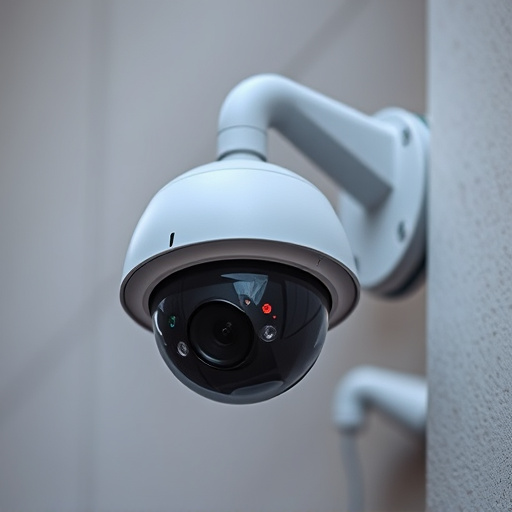Solar-powered dummy security cameras utilize strategic Dummy Camera Red Light Placement to deter intruders and capture motion-activated footage. Key components include solar panels and batteries for independence from traditional power sources. Proper placement in well-lit areas during the day enhances visibility, while regular cleaning ensures optimal performance, mimicking real camera activity for cost-effective, eco-friendly surveillance.
“Discover the innovative world of solar-powered dummy security cameras, a game-changer in home and business surveillance. These sleek devices combine renewable energy with advanced technology, offering a sustainable and effective security solution. In this comprehensive guide, we’ll explore the inner workings of these cameras, from understanding their key components—solar panels and batteries—to optimizing the strategic placement of red lights for enhanced visibility. Learn practical installation tips to ensure maximum effectiveness and peace of mind.”
- Understanding Solar-Powered Dummy Cameras
- Key Components: Panels and Batteries
- Optimal Red Light Placement for Visibility
- Installation Tips for Maximum Effectiveness
Understanding Solar-Powered Dummy Cameras
Solar-powered dummy security cameras are a clever and environmentally friendly alternative to traditional surveillance systems. These devices operate solely on solar energy, drawing power from sunlight during the day and storing it in rechargeable batteries for night-time operation. One key feature is the strategic placement of a red light, designed to mimic the flash of a real camera’s infrared or visible light sensor. This dummy camera red light placement serves two purposes: first, it discourages potential intruders by indicating the presence of surveillance, and second, it triggers the camera to capture footage when motion is detected, providing a deterrent effect.
The red light isn’t just a visual cue; it’s part of the camera’s advanced motion detection mechanism. When the built-in sensor picks up any movement, the red light flashes, signaling the camera to activate and record video or still images. This simple yet effective technology makes solar-powered dummy cameras an attractive option for both residential and commercial security, offering a cost-efficient and eco-conscious solution without compromising on surveillance capabilities.
Key Components: Panels and Batteries
The heart of any solar-powered dummy security camera lies in its key components—specifically, the solar panels and batteries. These two elements work in tandem to ensure the camera’s longevity and independence from traditional power sources. Solar panels, strategically positioned for optimal sunlight exposure, harness the energy from the sun, converting it into electricity to charge the integrated batteries.
The dummy camera’s red light placement is a crucial consideration here. This light serves not only as a motion-activated warning but also indicates when the camera is actively charging. By utilizing solar power, these cameras offer a sustainable and cost-effective solution for home or business security, eliminating the need for complex wiring and regular electricity bills—all while maintaining a vigilant watch over your premises.
Optimal Red Light Placement for Visibility
The placement of red lights on solar-powered dummy security cameras is a strategic consideration for enhancing visibility during low-light conditions. Optimal positioning ensures that the camera’s field of view is well-lit, allowing clear and detailed surveillance. Typically, the red light should be placed at the top or front of the camera body to mimic natural lighting sources, such as the sun or streetlights. This orientation projects the light downwards and outwards, covering a broader area without creating excessive glare that could obscure the camera’s lens.
When installing these cameras, positioning them in areas with direct sunlight during the day and minimal obstructions from trees or buildings can maximize the effectiveness of the red lights. Additionally, ensuring the lights are angled correctly helps prevent reflections on nearby windows or shiny surfaces, which could otherwise interfere with the camera’s performance. Proper Dummy Camera Red Light Placement contributes significantly to the overall quality of surveillance, especially in outdoor environments where lighting conditions vary throughout the day.
Installation Tips for Maximum Effectiveness
To maximize the effectiveness of solar-powered dummy security cameras, careful consideration should be given to their placement and accompanying lights. The red light feature is a key component, designed to mimic the glow of real camera activity and deter potential intruders. Strategically positioning these cameras in areas with ample sunlight exposure during the day ensures consistent power generation.
When installing your dummy cameras, place them in visible locations where they can be easily seen, such as near entry points or along perimeters. The red light should be positioned to cast a clear view onto potential target areas, creating the illusion of constant surveillance. Regular cleaning and maintenance are also crucial for optimal performance; keep the solar panels free from debris to allow sunlight penetration and ensure the camera’s longevity in various weather conditions.
Solar-powered dummy security cameras offer a sustainable and cost-effective solution for home and business security. By understanding their key components, optimal red light placement for visibility, and installation tips, you can maximize their effectiveness as deterrents. Remember that proper placement is crucial; strategic positioning ensures these cameras serve as visible reminders of surveillance, enhancing overall security without breaking the bank.
